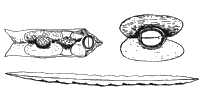The Environmental Engineering Group at Leicester University, UK, has been studying the potential use of natural coagulants on a large scale in water treatment works. Their work has looked at the natural coagulation properties of crushed seed of the Moringa oleifera tree. This is a native of northern India which is now grown widely through the tropics. It is sometimes known as ‘drumstick’ (because of the shape of its pods) and ‘horseradish’ (describing the taste of its roots). Moringa grows rapidly from seed or cuttings, even in poor soils. It needs little care and can survive long periods of drought. It grows rapidly – growth of up to 4 metres in height, flowering and fruiting were all observed within one year of planting during trials near Nsanje, Southern Malawi. In some areas of Southern India, two harvests of seed pods are possible in a single year. As the table shows, the tree has many uses.
Household water treatment
Seed pods should be left to mature on the tree and harvested when dry. The light ‘wings’ and shells of the seeds are easily removed, leaving the white seed kernels. These are finely crushed and pounded, using a pestle and mortar. The amount of seed needed to treat river water depends on how much suspended matter the water contains. Users quickly become familiar with the changing needs of their particular water as the quantity of sediment changes with the seasons.
To treat 20 litres of water (the amount carried in the average large bucket) about 2 grams of crushed seed is needed (2 level 5ml teaspoons or 2 rounded soda bottle tops). Add a small amount of clean water to the crushed seed to form a paste. Put the paste into a clean bottle – a soda bottle is ideal. Add a cup (200ml) of clean water and shake for 5 minutes. This action activates the chemicals in the crushed seed.
Filter this solution through white cotton cloth into a 20 litre bucket of river water. The contents are stirred rapidly for 2 minutes, followed by slow stirring for 10–15 minutes. During this slow mixing period, the moringa seed binds together (coagulates) the fine particles and bacteria into larger particles which sink and settle at the bottom of the bucket. After an hour, clear water can be drawn off.
This process will remove 90–99.9% of the bacteria which are attached to the solid particles, as well as clearing the water. However, some harmful microorganisms still in the water may not be removed, especially if the water is very badly polluted. For drinking water, further purification is recommended – either by boiling or with a simple sand filter. The dried seeds (remove discoloured ones) and powder can be stored. However, the paste must be prepared fresh each day.
Large scale water treatment
Our experimental work was carried out at Thyolo in Southern Malawi where a water treatment works was built as a model system for village water treatment. Electrical power is not required for operation. In Malawi in 1993, imported chemicals from South Africa cost the Water Utilities over £400,000 in valuable foreign exchange. Our trials using moringa seed gave water purification results which were just as good as those obtained with commercial chemicals – at a fraction of the cost. 50–150mg of ground seed is needed for 1 litre of water. Simple jar tests will determine how much seed is needed.
Many developing countries could save huge amounts of money by adopting these ideas.
Moringa as a vegetable and oil source
Moringa pods are an important commercial vegetable crop throughout India. In the south many varieties have been developed with a range of pod lengths, and growing periods. They are sold fresh in local markets. Immature green pods are cut into sections and canned in brine for export to Europe and America.
Elsewhere in the world moringa trees are prized by villagers for their pods and leaves. The leaves have a high protein content of 27% and are rich in vitamins A and C, calcium, iron and phosphorus. A particular advantage is that moringa leaves can be harvested during the dry season when no other fresh vegetables are available.
Moringa seed contains 40% by weight of oil. Laboratory tests at Leicester confirmed that the presscake remaining after oil extraction still contains the active coagulants. It can be used to treat water in just the same way as already described. Presscake can also be dried and stored. It may be obtained without cost as a by-product of oil extraction.
This is a very important point. Moringa seeds can be used first for oil extraction, without reducing their effectiveness for water treatment. Moringa oil is of high quality and potentially has a high market value. The oil is of equal value both for cooking oil and as the main ingredient for soap manufacture. The demand for oil in Malawi is far greater than present production within the country. Soya bean oil is therefore imported from South America.
A visit was made to a village in southern Malawi that had many moringa trees, loaded with green pods. The trees are highly prized for this vegetable source but the villagers had not harvested the pods as they could not afford the imported vegetable oil necessary to cook them and they did not realise the moringa was itself a source of oil.
Conclusions
The planting of moringa trees by smallholder farmers should be encouraged. It will improve both their health and income. This valuable tree will provide both fresh vegetables and raw materials for oil extraction. Simple technology is available to encourage small scale oil milling enterprises to be established in the rural areas. Tests are being carried out by ITDG Zimbabwe.
The great potential of the tree and its various products has not been recognised. In southern Nigeria, the moringa tree is known as idagba manoye – which translates as ‘growing up without sense’. One can hope that in the future, good sense prevails and the true potential of this tree and its many products is realised.
If readers have difficulty in locating local specimens, small sample packets of seeds may be obtained from… ECHO 17430 Durrance Road, North Fort Myers FL, 33917-2200, USA. Check your country’s regulations for importing legume seeds first.
Geoff Folkard and John Sutherland are members of the Environmental Engineering Group at the University of Leicester. They invite correspondence from readers on the cultivation of the many varieties of moringa oleifera and from those with experience of moringa oil extraction and use. They may be contacted at…
Department of Engineering University of Leicester Leicester, LE1 7RH









